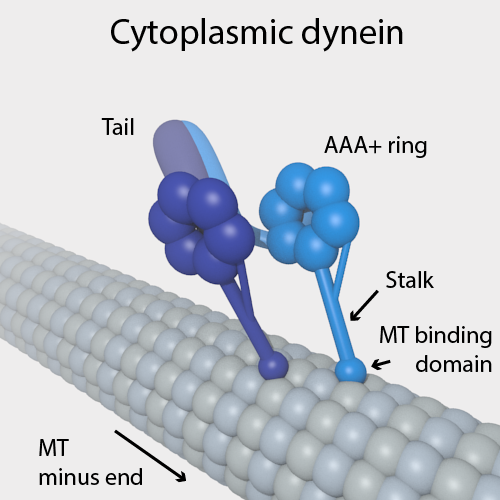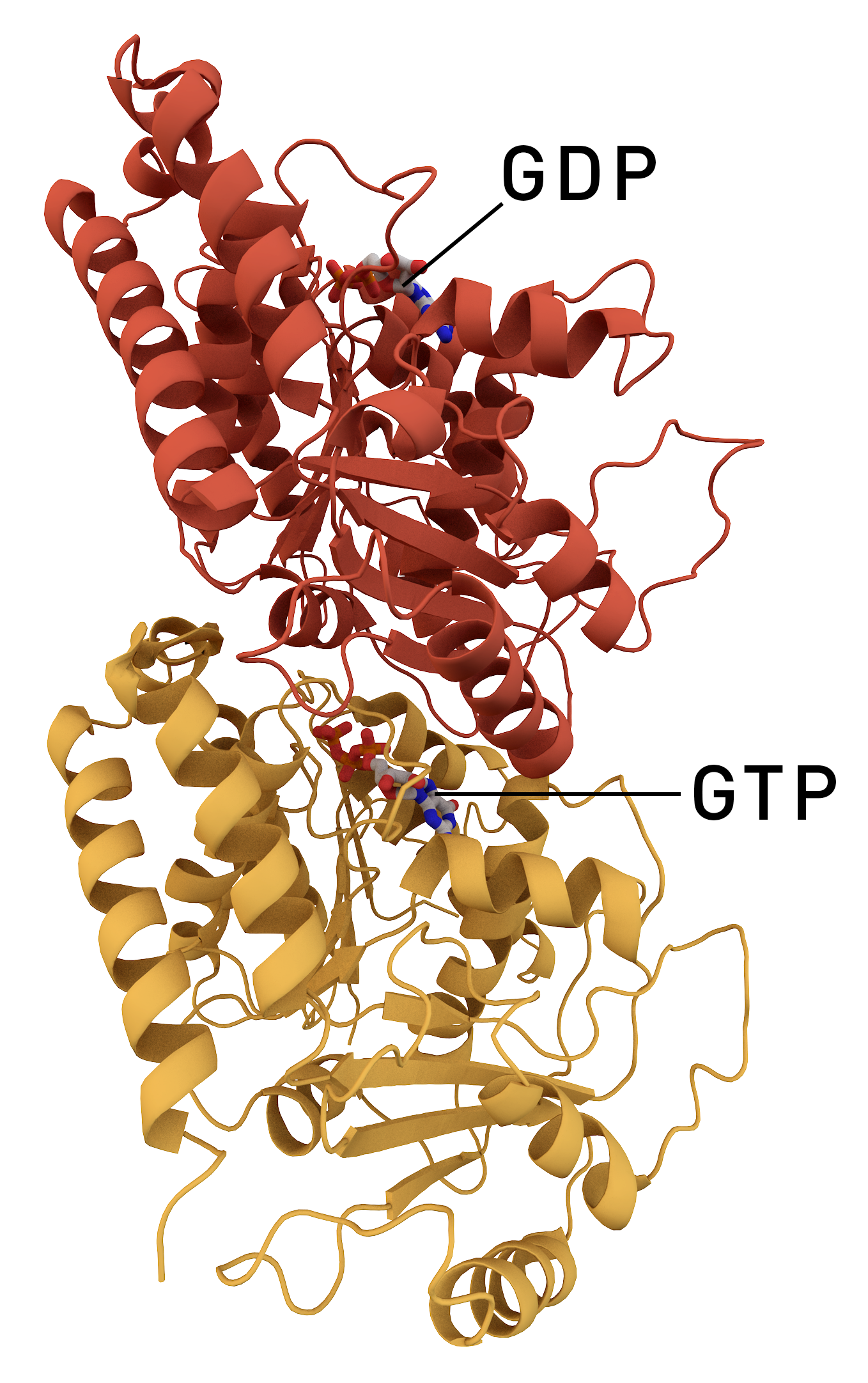|
Dynactin
Dynactin is a 23 subunit protein complex that acts as a co-factor for the microtubule motor cytoplasmic dynein-1. It is built around a short filament of actin related protein-1 ( Arp1). Discovery Dynactin was identified as an activity that allowed purified cytoplasmic dynein to move membrane vesicles along microtubules in vitro. It was shown to be a multiprotein complex and named "dynactin" because of its role in dynein activation. The main features of dynactin were visualized by quick-freeze, deep-etch, rotary shadow electron microscopy. It appears as a short filament, 37-nm in length, which resembles F-actin, plus a thinner, laterally oriented arm. Antibody labelling was used to map the location of the dynactin subunits. Structure Dynactin consists of three major structural domains: (1) sidearm-shoulder: DCTN1/p150Glued, DCTN2/p50/dynamitin, DCTN3/p24/p22;(2)the Arp1 filament: ACTR1A/Arp1/centractin, actin, CapZ; and (3) the pointed end complex: Actr10/Arp11, DCTN4/p62, DC ... [...More Info...] [...Related Items...] OR: [Wikipedia] [Google] [Baidu] |
DCTN1
Dynactin subunit 1 is a protein that in humans is encoded by the ''DCTN1'' gene. Function This gene encodes the largest subunit of dynactin, a macromolecular complex consisting of 23 subunits (11 individual proteins ranging in size from 22 to 150 kD). Dynactin binds to cytoplasmic dynein, dynein cargo adaptors, and microtubules. It is involved in a diverse array of cellular functions, including ER-to-Golgi transport, the centripetal movement of lysosomes and endosomes, spindle formation, chromosome movement, nuclear positioning, and axonogenesis. This subunit is commonly referred to p150-glued. It is present in two copies per dynactin complex and forms an ≈75 nm long flexible arm that extends from the main body of dynactin. The p150-glued arm contains binding sites for microtubules, the microtubule plus tip binding protein EB1, and the N-terminus of the dynein intermediate chain. Alternative splicing of this gene results in at least 2 functionally distinct isoform ... [...More Info...] [...Related Items...] OR: [Wikipedia] [Google] [Baidu] |
DCTN2
Dynactin subunit 2 is a protein that in humans is encoded by the ''DCTN2'' gene Function This gene encodes a 50-kD subunit of dynactin, a macromolecular complex consisting of 23 subunits (11 individual proteins ranging in size from 22 to 150 kD). The subunit is commonly referred to as p50 or dynamitin. Dynactin binds to both microtubules and cytoplasmic dynein. It is involved in a diverse array of cellular functions, including ER-to-Golgi transport, the centripetal movement of lysosomes and endosomes, spindle formation, chromosome movement, nuclear positioning, and axonogenesis. This subunit is present in 4 copies per dynactin molecule. It contains three short alpha-helical coiled-coil domains that bind to two copies of p150-glued (DCTN1) and two copies of p24 (DCTN3) to form the dynactin shoulder domain. Interactions DCTN2 has been shown to interact Advocates for Informed Choice, dba interACT or interACT Advocates for Intersex Youth, is a 501(c)(3) nonprofit organi ... [...More Info...] [...Related Items...] OR: [Wikipedia] [Google] [Baidu] |
DCTN6
In molecular biology, DCTN6 is that subunit of the dynactin protein complex that is encoded by the p27 gene. Dynactin is the essential component for microtubule-based cytoplasmic dynein motor activity in intracellular transport of a variety of cargoes and organelles. Identification and structure DCTN6 was first identified and cloned as a subunit of the "pointed-end complex" of dynactin through biochemical purification. X-ray crystal structure revealed that dynactin p27 forms an unusual left handed β-helix (LβH) domain, and its phosphorylation site T186 is in C-terminal disordered segment. Function In intracellular transport Dynactin p27 forms a hetero-dimer with the other dynactin pointed-end complex subunit p25/DCTN5 in 1:1 ratio, and it is essential for p25 stability since they are co-knockdown by p27 RNAi. However, both p27 and p25 are not required for 19S dynactin complex integrity verified by velocity sedimentation. p27/DCTN6 and other dynactin pointed-end complex sub ... [...More Info...] [...Related Items...] OR: [Wikipedia] [Google] [Baidu] |
ACTR1A
Alpha-centractin (yeast) or ARP1 is a protein that in humans is encoded by the ''ACTR1A'' gene. Function This gene encodes a 42.6 kD subunit of dynactin, a macromolecular complex consisting of 10-11 subunits ranging in size from 22 to 150 kD. Dynactin binds to both microtubules and cytoplasmic dynein. It is involved in a diverse array of cellular functions, including ER-to-Golgi transport, the centripetal movement of lysosomes and endosomes, spindle formation, chromosome movement, nuclear positioning, and axonogenesis. This subunit is present in 8-13 copies per dynactin molecule, and is the most abundant molecule in the dynactin complex. It is an actin-related protein, and is approximately 60% identical at the amino acid level to conventional actin. ARP1 forms a 37 nm filament-like structure and is the core of the dynactin complex. It only exists in the dynactin complex in vivo. Highly purified, native Arp1 polymerize rapidly at extremely low concentrations into short filam ... [...More Info...] [...Related Items...] OR: [Wikipedia] [Google] [Baidu] |
Dynein
Dyneins are a family of cytoskeletal motor proteins that move along microtubules in cells. They convert the chemical energy stored in ATP to mechanical work. Dynein transports various cellular cargos, provides forces and displacements important in mitosis, and drives the beat of eukaryotic cilia and flagella. All of these functions rely on dynein's ability to move towards the minus-end of the microtubules, known as retrograde transport; thus, they are called "minus-end directed motors". In contrast, most kinesin motor proteins move toward the microtubules' plus-end, in what is called anterograde transport. Classification Dyneins can be divided into two groups: cytoplasmic dyneins and axonemal dyneins, which are also called ciliary or flagellar dyneins. * cytoplasmic ** heavy chain: DYNC1H1, DYNC2H1 ** intermediate chain: DYNC1I1, DYNC1I2 ** light intermediate chain: DYNC1LI1, DYNC1LI2, DYNC2LI1 ** light chain: DYNLL1, DYNLL2, DYNLRB1, DYNLRB2, DYNLT1, DYN ... [...More Info...] [...Related Items...] OR: [Wikipedia] [Google] [Baidu] |
Cytoplasmic Dynein
Dyneins are a family of cytoskeletal motor proteins that move along microtubules in cells. They convert the chemical energy stored in ATP to mechanical work. Dynein transports various cellular cargos, provides forces and displacements important in mitosis, and drives the beat of eukaryotic cilia and flagella. All of these functions rely on dynein's ability to move towards the minus-end of the microtubules, known as retrograde transport; thus, they are called "minus-end directed motors". In contrast, most kinesin motor proteins move toward the microtubules' plus-end, in what is called anterograde transport. Classification Dyneins can be divided into two groups: cytoplasmic dyneins and axonemal dyneins, which are also called ciliary or flagellar dyneins. * cytoplasmic ** heavy chain: DYNC1H1, DYNC2H1 ** intermediate chain: DYNC1I1, DYNC1I2 ** light intermediate chain: DYNC1LI1, DYNC1LI2, DYNC2LI1 ** light chain: DYNLL1, DYNLL2, DYNLRB1, DYNLRB2, DYNLT1, DYNLT3 * axonem ... [...More Info...] [...Related Items...] OR: [Wikipedia] [Google] [Baidu] |
DCTN3
Dynactin subunit 3 is a protein that in humans is encoded by the ''DCTN3'' gene. This gene encodes the smallest subunit of dynactin, a macromolecular complex consisting of 10 subunits ranging in size from 22 to 150 kD. Dynactin binds to both microtubules and cytoplasmic dynein. It is involved in a diverse array of cellular functions, including ER-to-Golgi transport, the centripetal movement of lysosomes and endosomes, spindle formation, cytokinesis, chromosome movement, nuclear positioning, and axonogenesis. This subunit, like most other dynactin subunits, exists only as a part of the dynactin complex. It is primarily an alpha-helical protein with very little coiled coil, and binds directly to the largest subunit (p150) of dynactin. Alternative splicing of this gene generates 2 transcript variant Alternative splicing, or alternative RNA splicing, or differential splicing, is an alternative splicing process during gene expression that allows a single gene to code for multiple ... [...More Info...] [...Related Items...] OR: [Wikipedia] [Google] [Baidu] |
DCTN4
Dynactin subunit 4 is a protein that in humans is encoded by the DCTN4 gene In biology, the word gene (from , ; "... Wilhelm Johannsen coined the word gene to describe the Mendelian units of heredity..." meaning ''generation'' or ''birth'' or ''gender'') can have several different meanings. The Mendelian gene is a b .... References Further reading * * * * * * {{gene-5-stub ... [...More Info...] [...Related Items...] OR: [Wikipedia] [Google] [Baidu] |
Microtubules
Microtubules are polymers of tubulin that form part of the cytoskeleton and provide structure and shape to eukaryotic cells. Microtubules can be as long as 50 micrometres, as wide as 23 to 27 nm and have an inner diameter between 11 and 15 nm. They are formed by the polymerization of a dimer of two globular proteins, alpha and beta tubulin into protofilaments that can then associate laterally to form a hollow tube, the microtubule. The most common form of a microtubule consists of 13 protofilaments in the tubular arrangement. Microtubules play an important role in a number of cellular processes. They are involved in maintaining the structure of the cell and, together with microfilaments and intermediate filaments, they form the cytoskeleton. They also make up the internal structure of cilia and flagella. They provide platforms for intracellular transport and are involved in a variety of cellular processes, including the movement of secretory vesicles, or ... [...More Info...] [...Related Items...] OR: [Wikipedia] [Google] [Baidu] |
Microtubule
Microtubules are polymers of tubulin that form part of the cytoskeleton and provide structure and shape to eukaryotic cells. Microtubules can be as long as 50 micrometres, as wide as 23 to 27 nm and have an inner diameter between 11 and 15 nm. They are formed by the polymerization of a dimer of two globular proteins, alpha and beta tubulin into protofilaments that can then associate laterally to form a hollow tube, the microtubule. The most common form of a microtubule consists of 13 protofilaments in the tubular arrangement. Microtubules play an important role in a number of cellular processes. They are involved in maintaining the structure of the cell and, together with microfilaments and intermediate filaments, they form the cytoskeleton. They also make up the internal structure of cilia and flagella. They provide platforms for intracellular transport and are involved in a variety of cellular processes, including the movement of secretory vesicles, ... [...More Info...] [...Related Items...] OR: [Wikipedia] [Google] [Baidu] |
DCTN5
Dynactin 5 (p25) is a protein that in humans is encoded by the DCTN5 gene. This gene encodes a subunit of dynactin, a component of the cytoplasmic dynein motor machinery involved in minus-end-directed transport. The encoded protein is a component of the pointed-end subcomplex and is thought to bind membranous cargo. A pseudogene of this gene is located on the long arm of chromosome 1. Alternatively spliced transcript variants encoding multiple isoforms have been observed for this gene. Model organisms Model organisms have been used in the study of DCTN5 function. A conditional knockout mouse line, called ''Dctn5tm2a(KOMP)Wtsi'' was generated as part of the International Knockout Mouse Consortium program — a high-throughput mutagenesis project to generate and distribute animal models of disease to interested scientists. Male and female animals underwent a standardized phenotypic screen to determine the effects of deletion. Twenty five tests were carried out on mutant mice and ... [...More Info...] [...Related Items...] OR: [Wikipedia] [Google] [Baidu] |




